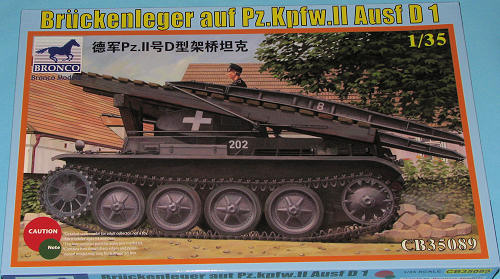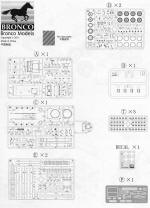
| KIT #: | CB35089 |
| PRICE: | $52.00 SRP |
| DECALS: | Two options |
| REVIEWER: | Scott Van Aken |
| NOTES: |

| HISTORY |
The Panzer II was the common name for a family of German tanks used in World War II. The official German designation was Panzerkampfwagen II (abbreviated PzKpfw II). Although the vehicle had originally been designed as a stopgap while more advanced tanks were developed, it nonetheless went on to play an important role in the early years of World War II, during the Polish and French campaigns. By the end of 1942 it had been largely removed from front line service, and production of the tank itself ceased by 1943. Its chassis remained in use as the basis of several other armored vehicles.
With a completely new Christie suspension with four road wheels, the Ausf. D was developed as a cavalry tank for use in the pursuit and reconnaissance roles. Only the turret was the same as the Ausf. C model, with a new hull and superstructure design and the use of a Maybach HL62TRM engine driving a seven-gear transmission (plus reverse). The design was shorter (4.65 m) but wider (2.3 m) and taller (2.06 m) than the Ausf. C. Speed was increased to 55 km/h. A total of 143 Ausf. D and Ausf. E tanks were built from May 1938 through August 1939 by MAN, and they served in Poland. They were withdrawn in March 1940 for conversion to other types after proving to have poor offroad performance.
After failed attempts to use the Panzer I as a chassis for a bridge layer, work moved to the Panzer II, led by Magirus. It is not known how many of these conversions were made, but four were known to have been in service with the 7th Panzer Division in May 1940.
| THE KIT |
 Bronco's kit is a real jewel. Though it is strictly a curbside, the kit provides all the opening hatches so that if one wishes, an engine and interior can be added. The inside of the turret is quite detailed so peering into it will show something other than blank walls. The kit's suspension is also quite detailed and fits onto a four piece hull assembly.
Bronco's kit is a real jewel. Though it is strictly a curbside, the kit provides all the opening hatches so that if one wishes, an engine and interior can be added. The inside of the turret is quite detailed so peering into it will show something other than blank walls. The kit's suspension is also quite detailed and fits onto a four piece hull assembly.
Those who are not fond of road wheels will appreciate the Christy suspension where they are large and easy to paint. Speaking of which, Bronco has provided colors for many of the parts that are attached to the kit if they are not the same as the outer shade (which is Panzer Grey, of course). While some are not enamored with separate track links, this kit provides them. Really, little looks as good as separate links and fortunately, those on the Panzer II are not complex at all.
There is the usual mass of tools and equipment to attach to the outer hull and both the20mm cannon and the machine gun for the turret are well done. A small etched sheet is provided to give details that are too fine for injected plastic.
The major difference between this and the earlier Ausf D kit is, of course, the bridge and its various mechanisms. This is included on two identical sprues for the left and right side of the bridge assembly. It looks to me that the rest of the kit is standard and includes the turret and gun, as all of that was retained with the specialized version.
Instructions are the superbly printed, glossy, full color booklet we have come to expect from Bronco. The small decal sheet provides markings for a single Panzer Grey vehicle from an unknown unit is Poland during 1939.
| CONCLUSIONS |
It is nice to see that Bronco apparently is going to do a series of later Panzer II tanks and specialty vehicles. The bridgelayer is a rather unique and specialized version that will add some character to any armor collection. On a different note, I have noticed that on recently reviewed Bronco kits, two of the corners of the box top have not been glued. Those who are familiar with how difficult Bronco boxes can be to get open may appreciate this feature, even if it is unintentional.
| REFERENCES |
December 2011
Thanks to www.dragonmodelsusa.com for the preview kit. Get yours today at your local shop or have them order it for you.
If you would like your product reviewed fairly and fairly quickly, please contact the editor or see other details in the